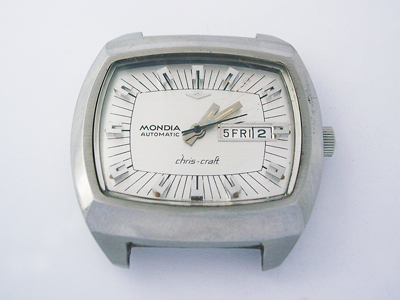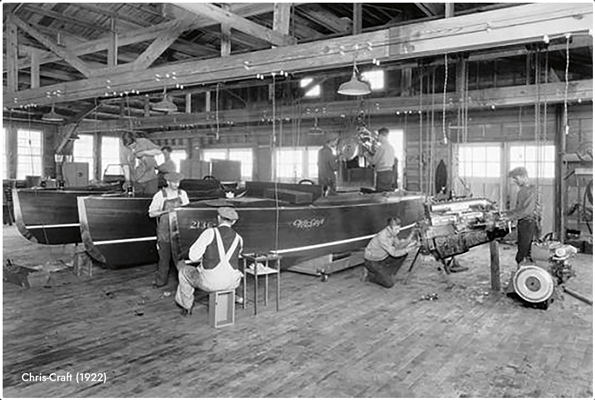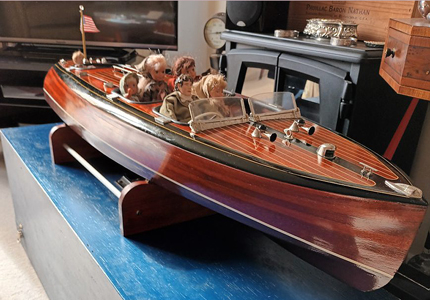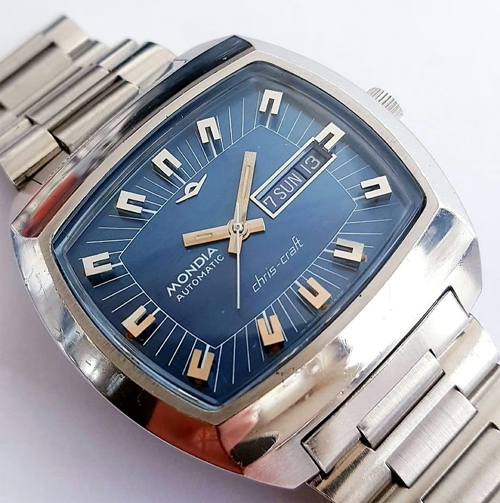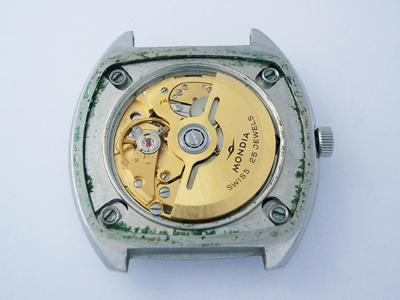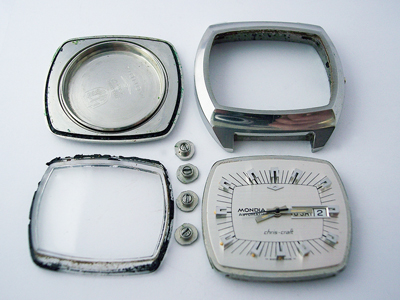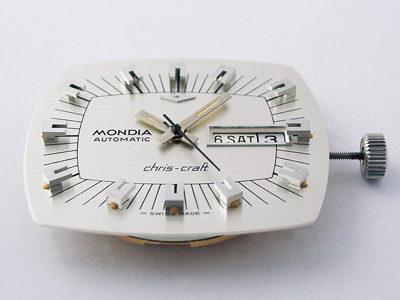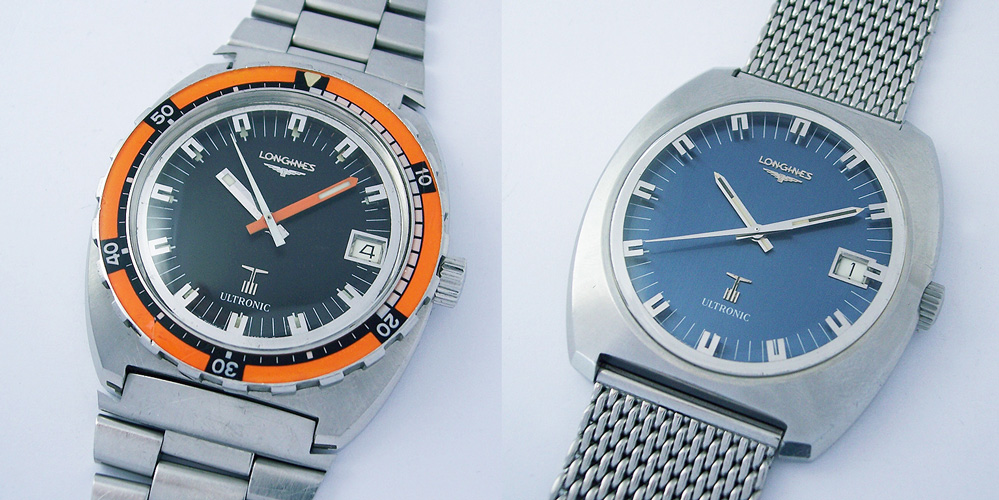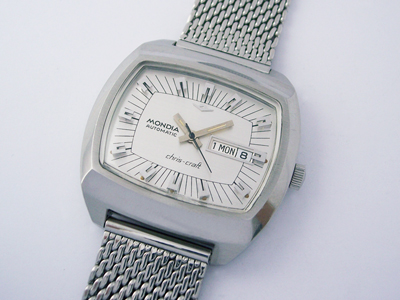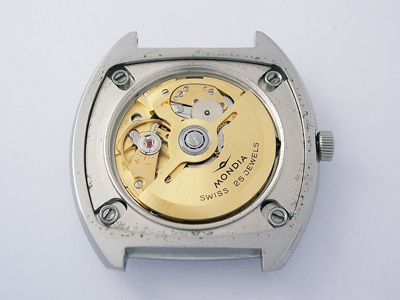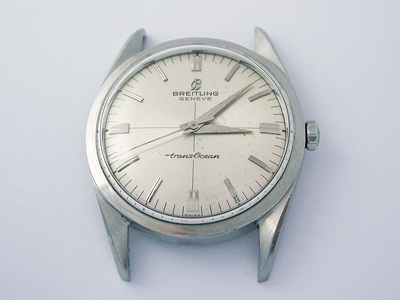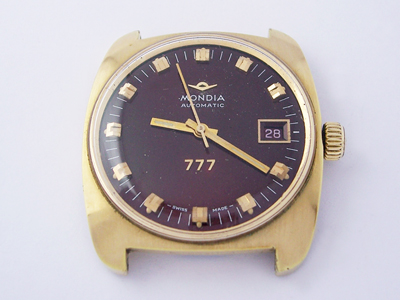Bearing design hallmarks typical of a 1970’s watch, this visual delight is a Mondia Chris-Craft Automatic.
(Click pictures to enlarge)
“TV” cases were much more common in the 1970’s than they are today and there has only been a couple on the blog in the past, namely the Memostar Alarm and the Favre-Leuba Sea Raider.
There has only been one Mondia model on the blog too, the equally quirky Mondia Top Second, where I included a brief history of the brand and its link with Zenith. The curious “Chris-Craft” branding on the dial however, is not only the model name for this watch, but also a brand tie-in.
Chris-Craft is a US company famous for creating luxury, hand-built, mahogany boats. Started in Algonac, Michigan, by a then 13-year-old Christopher Columbus Smith, the first boat was built in 1874, after which he teamed up with his brother to produce boats full time for a growing market. By the 1950’s, the company had become the largest producer of mahogany powerboats in the world, offering 139 different models.
The company is still in business today (www.chriscraft.com) and while the boats have moved on somewhat from the classic mahogany ‘barrel-back’ models of the past, their vintage boats are still sought after by enthusiasts.
If your budget can’t stretch to a full-sized version, you could always pick up a miniature radio-controlled version instead. This 1.2 metre scale model belongs to the owner of the watch in this post, bought subsequently as a companion/conversation piece.
The reason for the collaboration between Chris-Craft and Mondia is unclear and there is no information that I could find online suggesting exactly why this model was created. It seems quite niche to be purely a marketing effort, so perhaps it was included when a specific model of boat was purchased? Or sold exclusively in the company shop? If anyone has any further information on the history of this somewhat curious collaboration, then I’d certainly be interested to hear it.
It’s also worth noting that as well as the silver dial here, the watch was also available in an equally attractive blue dialled version. Both would have been originally fitted with a Mondia branded stainless steel bracelet.
The case construction on this watch is unusual and did cause me quite a bit of trouble. The caseback is a standard screwback with a captive cover for the movement which once removed, allows access to four screws securing the movement inside the outer case.
The idea is to loosen the four screws and slide them inwards towards the movement and the inner case should then drop out of the outer case for further disassembly… well, that’s the theory anyway!
As you can see in the picture above, the case had quite a bit of what can only be described in technical watchmaking terms as ‘green goo’ inside. This goo had seeped between the two casing parts, effectively glueing them together, and no amount of levering from any angle resulted in even a hint of movement. So, what to do now?
I thought gently warming the watch might help, but sadly not, so as a last resort, I slowly fed a small amount of water into the gap between the two casing parts with tweezers, hoping that it might dilute the goo enough and break the hold. Not exactly the recommended solution as had that not worked, the watch would then have moisture in it, but thankfully, the water did the trick and the parts separated with some effort.
As you can see above, the watch had obviously not been apart for decades as crystal gasket too had turned to black slime, but on this occasion the dial and hands had survived both flavours of goo unscathed.
Out of the case, the dial can be appreciated further, with the raised hour markers being the highlight.
Their design being reminiscent of some of the Longines Ultronic models from the same period.
Once out of the case, the movement service was straight forward. There was a small issue with the calendar, which just needed a new date jumper spring to resolve, but other than that, not much to report. The case was thoroughly cleaned (so long, goo!), the caseback and crystal gaskets replaced and the crystal polished to finish the job.
Having been in-situ for such a long time, the green goo had resulted in a small amount of pitting on the case, but with a new gasket in place, that won’t be of any concern going forward and is all hidden from view when the caseback is in place.
Rich.

